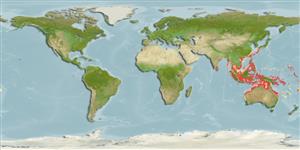Preferred temperature (Ref.
123201): 24.7 - 29, mean 28.1 °C (based on 882 cells).
Phylogenetic diversity index (Ref.
82804): PD
50 = 0.5000 [Uniqueness, from 0.5 = low to 2.0 = high].
Bayesian length-weight: a=0.00832 (0.00502 - 0.01379), b=3.08 (2.94 - 3.22), in cm total length, based on LWR estimates for this species & (Sub)family-body (Ref.
93245).
Trofisk nivå (Ref.
69278): 3.0 ±0.2 se; based on size and trophs of closest relatives
Generation time: 0.8 ( na - na) years. Estimated as median ln(3)/K based on 1
growth studies.
Resiliens (Ref.
120179): Hög, lägsta populationsfördubblingstid mindre än 15 månader (Preliminary K or Fecundity.).
Fishing Vulnerability (Ref.
59153): Low vulnerability (10 of 100).
Nutrients (Ref.
124155): Calcium = 443 [188, 1,054] mg/100g; Iron = 1.87 [1.03, 3.54] mg/100g; Protein = 18.2 [16.3, 19.8] %; Omega3 = 0.267 [0.106, 0.547] g/100g; Selenium = 39.1 [17.8, 88.0] μg/100g; VitaminA = 21.7 [7.0, 59.6] μg/100g; Zinc = 2.35 [1.58, 3.45] mg/100g (wet weight);
